
CHARLTON GLASSWORKS
A Conversation with the Artist
By Karen Burton
Tell us about who "Charlton Glassworks" is. How many people are involved in the business, who does what, when was it started, etc.
Charlton Glassworks is a family owned and operated glass studio. Sandie Charlton, my mother, is the founder and chief designer. Chad, the oldest son, is the talent behind our metalworks and oversees the daily production of our glass. While I, John, act as the assistant designer; I also coordinate the sales, marketing, production demands and shipping schedules."
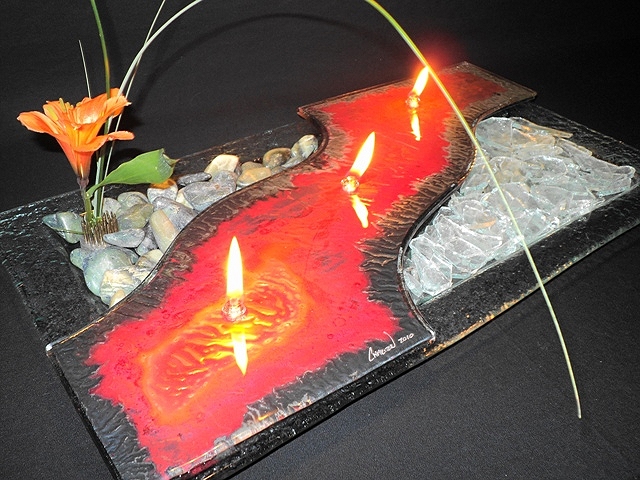
Aside from the family core, we have four full-time employees. Two on the production side and two on the finishing and shipping side. In addition to our in-house employees, we also have a small group of "stay at home Mom's" that hand-cut our copper on a piece work basis.
The genesis of Charlton Glassworks can be found in our father's history of working and developing glass technologies. To this day he actively develops and patents new machinery for decorative glass inserts for the housing industry (front doors, shower doors, cabinets, etc.).
Although Sandie, Chad and I all worked with our father in the past, Sandie and I thought it would be a more intimate and relaxed approach dealing with a base of galleries rather than serving big business.
Thus, Charlton Glassworks incubated its way through a series of Art-in-the-Park festivals for the first few years before attending our first wholesale trade show in 1998. In 2005, we attended 10 wholesale and no retail shows.
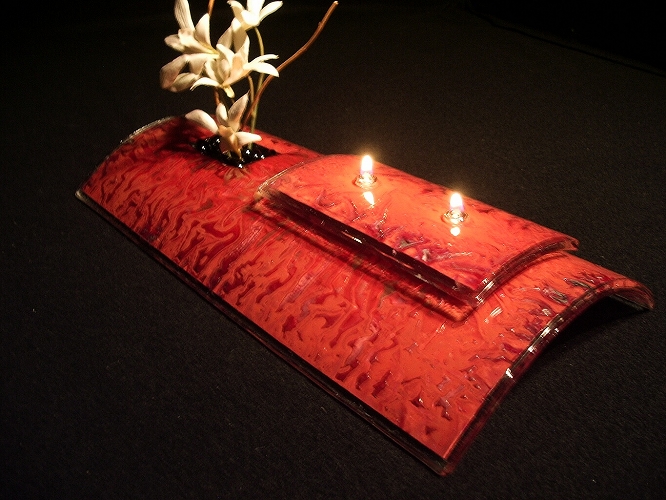
To this day we value our relationships with every one of our representing galleries. We are diligent not to over-market our glass by honoring territorial exclusivities to all of our galleries. In addition, we generate new designs for all summer and winter markets. This has insured a proactive and fresh appeal toward our line from our standpoint and that of our collectors.
What does "fused glass" mean?
Fused glass is the act of melting multiple layers of glass together. This is often combined with the use of inclusions (i.e. copper foil). At Charlton Glassworks, it is safe to say, we have tried to fuse almost everything on the planet between layers of glass. Some results are really cool; while others go straight to the dumpster.
Although the science of glass fusing can be rather complex, the basic premise is simple. Whatever elements you are fusing must expand and contract at the same ratio. There are different glass compositions, thus not all types of glass can be fused together. This same principal holds true to the inclusions. It is safe to assume that most fused glass does not incorporate inclusions; rather it is composed of layers of colored glass.
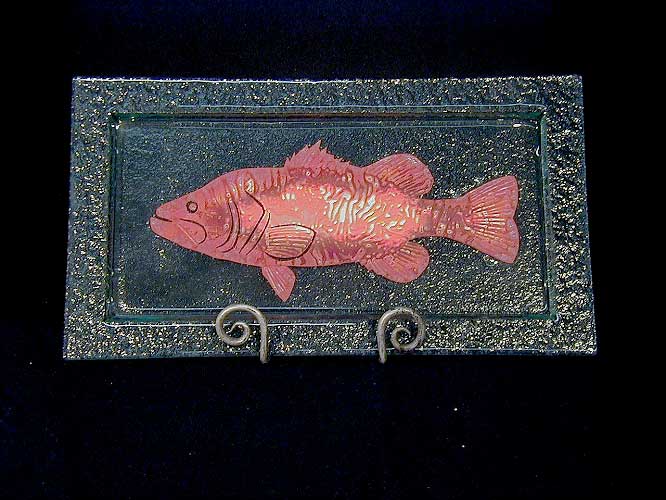
I see you are in Sedro-Woolley, Washington. Is there a connection with your use of sealife motifs?
Sedro-Woolley is located an hour north of Seattle and about an hour south of the Canadian border. Although our studio is not located on the water (we wish), our lives have always centered around the water. The San Juan Islands, an archipelago of 450 islands is within view. Our family has always enjoyed weekends at our little cabin on the water. In addition to our relationship with the water, it is hard to ignore the thousands of miles of waterfront poroperty in America. 70% of the population lives within 50 miles of the shore.
Where does the Japanese influence come from?
Aside from Sandie's infatuation with the Asian culture, a few years ago waterfront galleries on the West Coast began representing a strong "Pacific/Asian" look. Combined with the red tones in our glass and our initial sushi sets, the motivation has been unstoppable, even non-Asian items in our line are perceived as Asian.
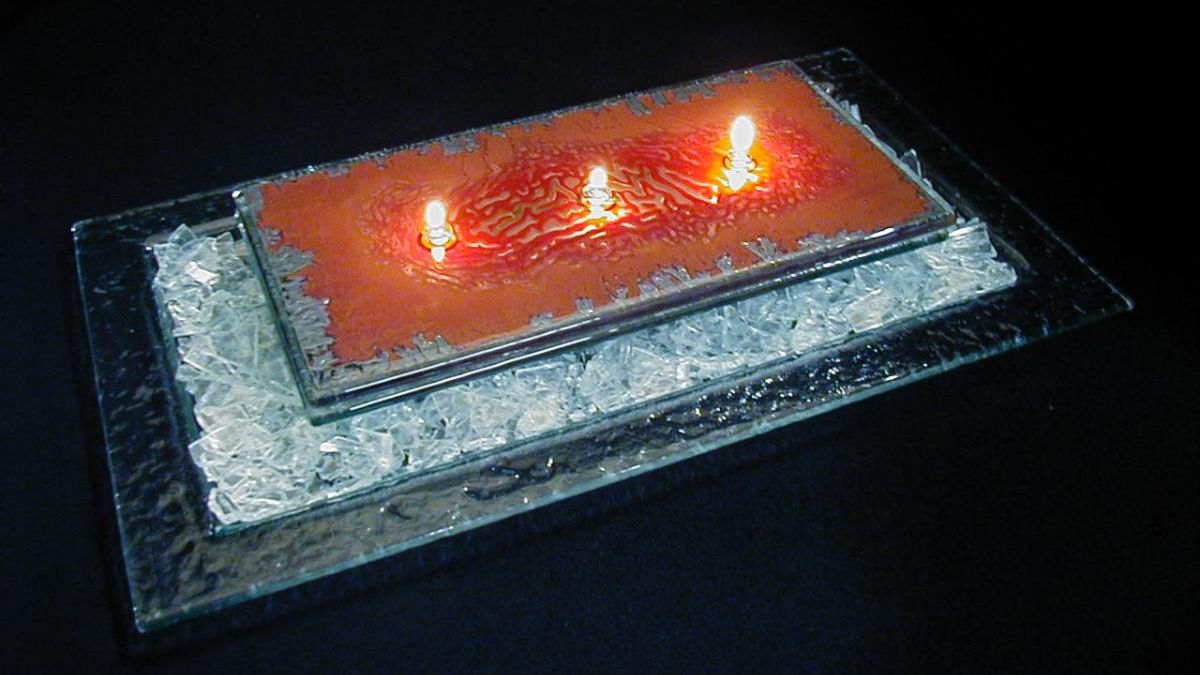
The oil lamps are beautiful. How did you come up with these designs? Trial/Error?
The initial design of our 5-wick, 4-wick, 3-wick, 2-wick, 1-wick and round oil lamps actually started with a 4-wick and a 1-wick and did not include the "glacial tray" (layer of smooth glass chips under the candle). We were attending our first wholesale trade show in Seattle and stopped by Pier 1 Imports to buy a small bag of crushed glass to display around the oil lamps at the show. Within an hour of the show opening, everyone wanted the "glacial tray." While Sandie was writing orders, I was on the phone searching for a wholesale source for the crushed glass to accurately price the oil lamps.
As our new designs hit the market, we would hear things like "Does this come with a wick?" or "Can this be made into an oil lamp?" As a result of these inquiries, we now have the extended oil lamp family of the "Terrace," "Sedona," "Arch," "Crossroads" and new designs on the way.
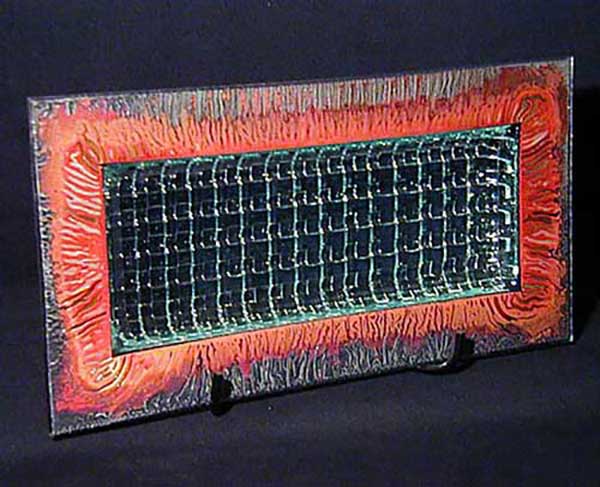
What technique do you use to create the woven platters?
Although we originally created a mold representing the woven texture on the surface, we were not thrilled with the definition on the surface. In our minds, this woven series is all about the texture. It is fun to watch people "pet" our glass. Knowing that the woven mold texture would not create our desired look, we went back to the drawing board. Each of the pieces is now created by first fusing two pieces of glass together with the copper border inclusion. We then lay the horizontal strips and vertical strips on top of the pre-fired piece for a final fuse.
How thick are the copper sheets? How big? Are they hard to cut and work with?
The copper, brass and steel foils we use in our process are .001 thick, or known as 1 mil. The copper rolls that we stock are 2 feet wide and roughly 500 feet long, weighing about 50 pounds. The brass and steel are only 6 inches and 12 inches wide and are 60 inches in length.
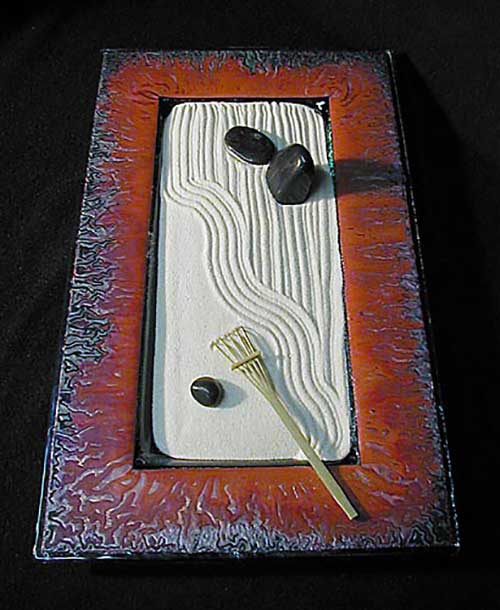
Do you keep a supply of band-aids around?
There is only one of our crew members that needs band-aids on a daily basis. Ironically, his name is Nick. It seems that those of us that have been here for awhile are accustomed to sharp (and hot) items.
How big are your kilns? How many pieces can you fire at one time?
We have designed and built all of our own kilns. The average size is five feet square and one foot deep. We have five of these kilns. Although these kilns were designed specifically for our platters and bowls (sealife), they were too shallow to accommodate our new line of three-dimensional (sculptural) works. We then designed two kilns that were eight by four feet and three feet deep. My brother and I are currently building another large kiln that will be twelve by five feet and three feet deep. In addition to that we are building two smaller R&D (research and development) kilns to facilitate prototype development here and at Sandie's soon-to-be home studio.
If the need were to arise and we implemented double firings on all kilns, we would have one of the largest glass fusing capacities in the nation. As I frequently tell my Mother, "It's not the cute little glass shop it used to be. On Monday's it's factory-like (joke) and on Friday it's a studio once again."
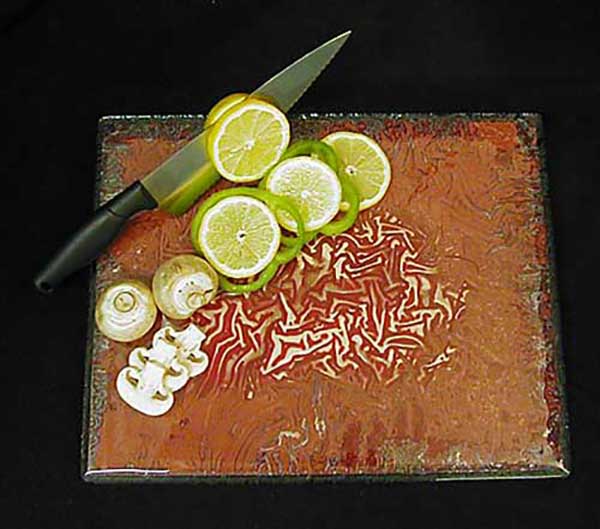
Are there precautions a customer needs to take in caring for your serving pieces?
As mentioned on our product tag, the only recommendations we suggest are to hand wash the pieces. Although they will survive the dishwasher, the overglaze will begin to break down over time. In addition, do not microwave because of the metal inclusions nor bake in the oven. You may serve hot foods off the grill and bang 'em around. They may be glass but they are durable.
Available Fused Copper and Glass Objects by Charlton Glassworks
This article may be reproduced, copied or quoted if credit is given to the author, Rendezvous Gallery and www.rendezvoustyle.com. Please provide a link to this web site. Prior written notice would be appreciated.